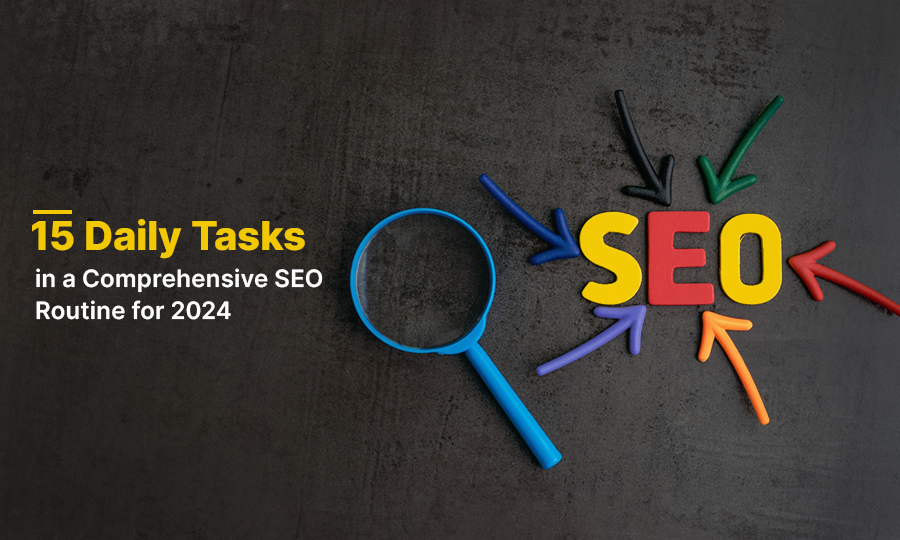Does your content marketing strategy follow a comprehensive SEO routine?
The Current State of Search Engine Optimization
Today, probably the only person who knows nothing about SEO is a boy who lived with a pack of wolves all his life and has just been introduced to the Internet and technology.
In the business world, SEO has become a buzzword and the foundation which supports all marketing campaigns.
- 82% of the marketers report that the significance of SEO is rising and will increase significantly
- 61% of marketers have a comprehensive SEO routine and say that it is their top inbound marketing priority
- Organic reach is one of the reasons why companies have a comprehensive SEO routine, as it 5.66 times better than paid traffic
Impact also reports that, since organic traffic will remain the main focus, the significance of SEO will keep growing, ultimately prompting Google and other search engines to create a more elaborate algorithm.
On the other hand, brands will have to keep up with growing SEO trends and follow a comprehensive SEO routine on a daily basis.
What is a Comprehensive SEO Routine?
Let’s start from afar.
All companies follow content marketing strategies. They create content, either for a blog or social media to increase their online presence and improve brand visibility.
However, random content doesn’t guarantee an increase in visibility. SEO is responsible for that. So, to have a successful content marketing strategy, you need to make sure that your content is ranked properly by a search engine.
Thus, a day in the life of an SEO professional starts from looking through a comprehensive list of tasks that they will have to do to support the company’s SEO strategy.
On the other hand, this routine won’t look the same as it was a year ago since there are so many changes already happening in how people are searching for information online.
So, what will this SEO daily checklist look like?
Let’s take a look.
1- Check SEO News Updates
What’s on the news today?
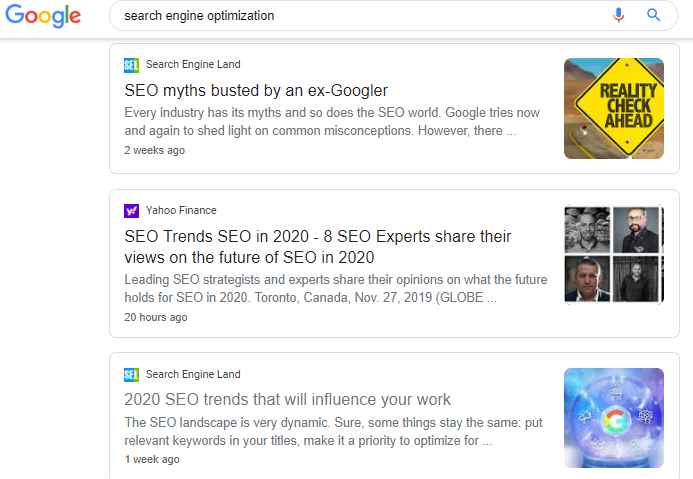
The importance of keeping up with the latest updates on search engine optimization is self-explanatory.
The SEO algorithm isn’t a static thing, it keeps developing, and without following updates, you risk missing out on the important changes that will impact your entire content marketing strategy.
What are the best resources that can help you keep up with upcoming SEO trends?
Here are some of our recommendations (besides our blog, of course):
- Google Webmaster Central Blog. Here you can find the latest news about the Google search console, fresh updates to the Google SEO algorithm, and reports about the upcoming SEO trends.
- Search Engine Journal. This online platform is a godsend for SEO professionals, where you can find everything from beginner guides to PPC guides and latest industry news.
- Search Engine Land. Another must-read resource with current industry updates and trend reports.
You can also skim through the news on Google, where you can sometimes find great resources to do competitor analysis.
2- Check for Duplicate Content
The holy grail of a good search engine optimization is original content. Thus, checking for duplicate content on your website is one of the main tasks of an SEO specialist.
Duplicate content is still an increasingly annoying problem for many brands.
No wonder.
There’s so much content online today that it’s hard to remain original.
Back in 2015, the report by Search Engine Land showed that 29% of websites struggled with duplicate content. Years went by, but the problem didn’t disappear, even though there are so many SEO tools to check SEO activities, plagiarism and duplicate content.
That’s why, as the volume of online content keeps increasing, checking for duplicate content will remain one of the main daily tasks of an SEO specialist, aimed at keeping content strategy original.
3- Do Keyword Research
Keywords aren’t going anywhere.
While doing keyword research is a no-brainer for an SEO specialist, there’s a relatively new SEO trend that will change the way how keyword research will be done in the nearest future.
We’re talking about semantic search.
Semantic research has nothing to do with simply identifying and listing keywords. Instead, before creating a list of keywords, you need to take into account:
- the variety of meanings behind a keyword
- different contexts, in which this keyword can be put, and how its meaning will change according to the context
- user intent behind this keyword and the context that it has been put in
These aspects together with the semantic connections between the keywords play an important role in multilingual SEO as well. If your company is present on the international market, it’s your task to research keywords in different languages.
Semantic research, in this case, plays an increasingly important role, as keyword contexts and user intent can be very different for, let’s say, an English-speaking and a Russian-speaking user.
4- Optimize Voice Search
Another growing trend that is expected to define SEO strategy in 2024 is voice search.
A 2017 report by Brafton predicted that by 2020, 50% of all searches will be voice searches. This is justified by the rising popularity of voice assistants and smart home systems controlled by voice search.
So, it adds another task to your daily SEO routine.
Voice search optimization, as much as keyword optimization in general, will be more focused on user intent in the upcoming years.
There are a couple more essential features to consider when doing voice search optimization besides user intent:
- Featured snippets – the most relevant content which appears at the top of the search. According to research, about 40% of all voice searches answers tested Google queries are featured snippets. If your content contains featured snippets, the voice assistant will be more likely to pull the information from your content:
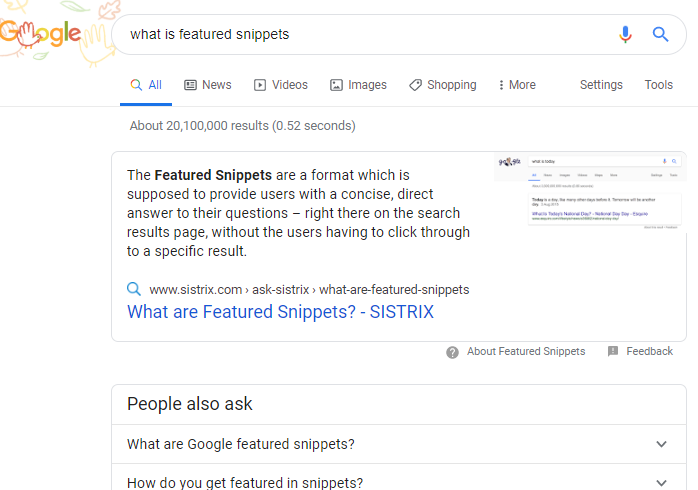
- Structured data – using schema markup, you can structure your content to help search engines read it more efficiently. The more structured your data is, the better the search engine will be able to recognize the details, which may be relevant for search inquiries. Hence, your voice assistant will be able to read these details to you:
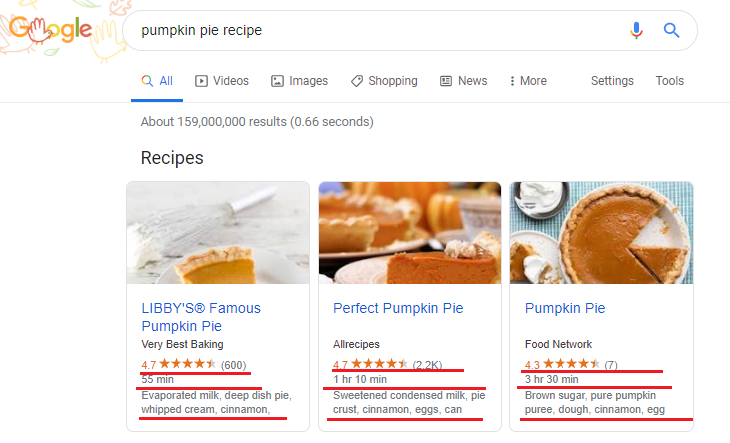
Since voice assistants become more and more available for the wide public, we can expect a significant spike voice search over the upcoming years.
So, now it’s time to make voice search optimization a daily task in a comprehensive SEO routine.
5- Optimize Visual Search
Visual search is another hot SEO trend for the upcoming year.
According to the research , 62% of millennials want the ability to visually search over any other technology. Thus, the whole image recognition market is expected to reach over $25 billion by 2020.
Visual recognition belongs to AI and is now adopted by many apps. For instance, Vivino scans wine bottles and provides users with information on the quality of wine:

Image credit: Vivino
Google has the same feature now, where you can enter a query and upload an image for a more detailed search:

Since now, according to the above-mentioned Social Media Today stats, visual search comprises over 19% of all search engine queries, it has to become one of the tasks in your comprehensive SEO routine.
Got to stick to the trends, right?
6- Optimize Visuals
This is a usual task for an SEO expert. And, in the upcoming year, it won’t go away. Image optimization for SEO usually includes:
- header images
- images that highlight quotes
- photos
- screenshots
- graphs and other images with stats
- infographics
- dynamic visuals, like GIFs
- video and audio materials
- interactive content – calculators, generators, quizzes, maps, etc.
The goal is to create shareable content that delivers a clear value, which a search engine can recognize. For this, an SEO professional should:
- properly name a file (by including relevant keywords)
- optimizing ALT attribute tags (helps a search engine recognize an image properly)
- optimizing image size for proper page load time
Visuals should complement and support your content, that’s why it will remain one of the key tasks in a comprehensive SEO routine for 2024.
7- Optimize Page Load Time
Another SEO routine task that isn’t going away next year is page load time optimization. A slowly loading page is what forces people to leave our website and never come back again.
Google webmasters say so themselves.
In an interview with Hobo Web, some Google SEO specialists admitted that 75% of people would never return to a website if it takes longer than 4 seconds to load.
4 seconds.
That’s your everyday goal.
A daily checklist of tasks to optimize page load time usually includes:
- cache optimization
- trimming down JavaScript Parsing
- getting rid of redirects that take extra processing time
Page load time optimization checklist also includes working on the implementation of CSS3 and HTML5 to make a website more lightweight, especially for mobile browsers.
8- Check Mobile Search
Let’s talk more about mobile search.
Three years ago, Google made a move towards mobile-first indexing. Due to an increasing number of search queries coming from mobile devices, Google now mobile-friendly sites first.
Mobile search optimization includes the tasks that have already been mentioned, including trimming down JavaScript Parsing, optimizing visuals, etc.
To speed down the process and not repeat the tasks all over again, Google created a Mobile-Friendly Test, which allows checking a website within a few seconds:
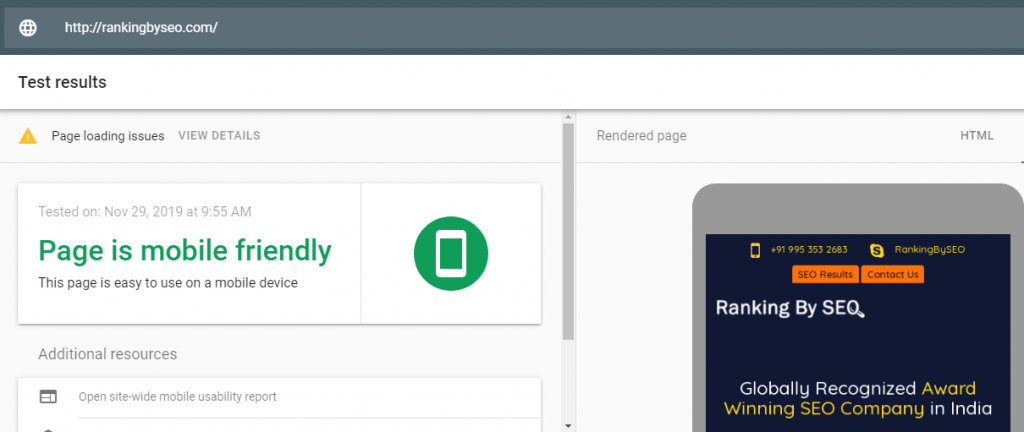
In case your website is not mobile-friendly, you’ll get a full report on the issues to work on.
9- Work on Meta Titles and Meta Descriptions
Meta titles and meta descriptions add value to your content. And, if your company follows a consistent content marketing strategy and you have fresh content coming up every day, working on meta titles and meta descriptions will remain your daily task.
Title tags and meta descriptions have an impact on:
- search engine result pages – title tags and meta descriptions determine a user’s first experience with your website
- how the page will display on web browsers – title tags act as placeholders to identify each page open in the browser
- to pin a link in social media posts to make it more interactive
It’s also a must-do daily task to check HTML attributes in the backend of the page for a search engine to recognize the code and place title tags and meta descriptions properly.
10- Check Link Building Status
It’s a frequently asked question whether Google is still using backlinks as an important determiner for the algorithm to rate a webpage.
Yes, and it is not going anywhere.
Backlinks are very important for the performance of the content. “Our research shows that 44% of top ranking websites on Google contain backlinks”, says Neightan Wight, a market researcher at GrabMyEssay. Backlinks are the backbone of the search engine algorithm, which is used to determine the quality of the article.
Checking the backlink status is important for a comprehensive SEO routine due to a number of reasons:
- to check for hidden links that decrease the value of content
- to eliminate link farms that can potentially get your website entirely banned
The most important reason to keep your link building status consistent is Google’s intent to patent the technology that will not only check the popularity of the sites that content has links to, but which will also check their trustworthiness.
This patent could potentially cause a great shift in how your website is ranked, so a daily check of the link building status is essential.
11- Build Unique URLs
A comprehensive SEO routine wouldn’t be complete without building unique URLs. This involves a daily check of the URL structure.
Why does it matter?
- You need to make sure that your website consistently delivers relevant results to users.
- Checking a URL for intuitiveness is important to help users easier navigate the website.
- Unique URLs help search engines break the content down into categories, which will impact the featured snippets, and how the website will be ranked.
Search engines like short but relevant unique URLs. You should also check the canonical tags for the search engine to not accidentally register different versions of the same page as two separate pages.
12- Check SERP Marketing Status
Search engines bet a lot on search engine result pages (SERPs).
So much so that SERPs have become an integral part of marketing campaigns.
Why are SERPs so important for marketing?
Getting to the top of search engine results pages means that you will drive as much organic traffic to your website as possible.
All the aforementioned tasks greatly contribute to your website’s position on search engine result pages. However, the main aspects that require a daily check are metadata tags that are responsible for creating rich snippets.
So, a daily check of the HTML tags and other metadata will ensure the consistency of your SERP marketing status.
13- Check the Status of your Local SEO Strategy
In the past two years, there has been a 900% growth in ‘near me tonight/today’ searches. This facilitated the trend of local SEO, which will remain relevant in the upcoming years.
Checking the status of your local SEO strategy involves:
- checking Google My Business account
- optimizing content for local news stories
- optimizing local keywords
You should also keep track of location pages and location-specific ‘About Us’ pages to keep your local SEO strategy in place.
14- Update Content Editorial Calendar
We’re finishing our comprehensive SEO routine for the upcoming year by making follow-ups to the editorial calendar.
SEO specialists often work with marketing teams and content creators on shared projects, using a content editorial calendar. SEO specialists often share lists of keywords and other SEO requirements with content writers in a shared content editorial calendar, and following it helps keep track of the marketing status.
Finishing up your day with updating content editorial calendar will also help you prepare for the next working day.
15- Collaborate with Other Marketing Teams
SEO consultants, as members of a search engine marketing team, work with other marketing teams, like CRM and SMM professionals, to create a consistent marketing strategy.
If you think that your agency requires a facelift, you can hire the services of a public relations company. However, ensure you do the minimum market research before zeroing in on one to obtain the maximum ROI.
Together, they collaborate on making sure that the company achieves its OKRs – Objectives and Key Results in terms of marketing and strategic planning.
Thus, many companies have a habit of different marketing teams getting together at the end of the working day to discuss what needs to be done to meet the OKRs.
Your part as an SEO specialist is to ensure that your company’s content marketing strategy is properly optimized for the search engines and that this content works in favor of your company’s online image.
Collaborating with other marketing teams is an essential step in finalizing your daily tasks and making sure that your company has a consistent SEO strategy.
Over to You
The daily routine of an SEO agency won’t change much in the upcoming year. The trends that will gain momentum next year, are already playing an important role in SEO routine today.
However, as SEO gets more and more complicated, it may get hard for you to keep up with every trend.
That’s why we invite you to follow our checklist of 15 daily tasks for a comprehensive SEO routine. With it, you’ll be more confident that your company has a consistent SEO strategy in place.
Additional Resources:
- The SEO Best Practices to Get the Top Ranking (Essential SEO Checklist 2022)
- Why Is SEO Important to a Business?
- SEO Keyword Research: 9 of the Biggest Mistakes You MUST Avoid


